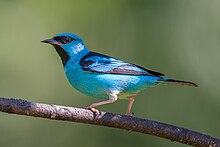Blue dacnis
| Blue dacnis | |
|---|---|

| |
| Adult male | |

| |
| Adult female in São Paulo, Brazil | |
| Scientific classification | |
| Domain: | Eukaryota |
| Kingdom: | Animalia |
| Phylum: | Chordata |
| Class: | Aves |
| Order: | Passeriformes |
| Family: | Thraupidae |
| Genus: | Dacnis |
| Species: | D. cayana
|
| Binomial name | |
| Dacnis cayana (Linnaeus, 1766)
| |

| |
| Synonyms | |
| |
The blue dacnis or turquoise honeycreeper (Dacnis cayana) is a small passerine bird. This member of the tanager family is found from Nicaragua to Panama, on Trinidad, and in South America south to Bolivia and northern Argentina. It is widespread and often common, especially in parts of its South American range.
Taxonomy
[edit]In 1760, the French zoologist Mathurin Jacques Brisson included a description of the blue dacnis in his Ornithologie based on a specimen collected in Cayenne in French Guiana. He used the French name Le Pepit bleu de Cayenne and the Latin name Sylvia cayanensis caerulea.[2] Although Brisson coined Latin names, these do not conform to the binomial system and are not recognised by the International Commission on Zoological Nomenclature.[3] When in 1766 the Swedish naturalist Carl Linnaeus updated his Systema Naturae for the twelfth edition he added 240 species that had been previously described by Brisson.[3] One of these was the blue dacnis. Linnaeus included a terse description, coined the binomial name Motacilla cayana and cited Brisson's work.[4] The specific name cayana is from Cayenne.[5] This species is now placed in the genus Dacnis that was introduced in 1816 by the French naturalist Georges Cuvier with the blue dacnis as the type species.[6][7]
Eight subspecies are recognised:[7]
- D. c. callaina Bangs, 1905 – west Costa Rica to southwest Panama
- D. c. ultramarina Lawrence, 1864 – Honduras to northwest Colombia
- D. c. napaea Bangs, 1898 – north, north-central Colombia
- D. c. baudoana Meyer de Schauensee, 1946 – southwest Colombia and west Ecuador
- D. c. caerebicolor Sclater, PL, 1851 – central Colombia
- D. c. cayana (Linnaeus, 1766) – east Colombia to French Guiana, Trinidad and north, central Brazil
- D. c. glaucogularis Berlepsch & Stolzmann, 1896 – south Colombia through east Ecuador and east Peru to north, east Bolivia
- D. c. paraguayensis Chubb, C, 1910 – east, south Brazil, east Paraguay and northeast Argentina
The purplish honeycreeper (Chlorophanes purpurascens), a bird from Venezuela known only from the type specimen, is considered to be an intergeneric hybrid between the green honeycreeper and either the red-legged honeycreeper or the blue dacnis.[8]
Description
[edit]The blue dacnis is 12.7 cm long and weighs 13 g. Despite its alternative name, it is not a honeycreeper, which are longer-billed. The adult male is turquoise blue with a black around the eyes, and on the throat and back. The wings and tail are black, edged with turquoise. The female and immature are mainly green with a blue head, paler green underparts and green-edged brown wings. The blue dacnis's call is a thin tsip.
Distribution and habitat
[edit]The blue dacnis occurs in forests and other woodlands, including gardens and parks.
Behaviour and ecology
[edit]The bulky cup nest is built in a tree and the normal clutch is of two to three grey-blotched whitish eggs. The female incubates the eggs, but is fed by the male.[9]
These are social birds which eat mainly insects gleaned from foliage, flowers or bromeliads. Fruit (such as licorice, Cecropia, Clusia, Miconia, berries, figs and bananas)[10] is often taken and usually swallowed whole, but nectar is rarely consumed.
References
[edit]- ^ BirdLife International (2016). "Dacnis cayana". IUCN Red List of Threatened Species. 2016: e.T22722991A94797202. doi:10.2305/IUCN.UK.2016-3.RLTS.T22722991A94797202.en. Retrieved 12 November 2021.
- ^ Brisson, Mathurin Jacques (1760). Ornithologie, ou, Méthode contenant la division des oiseaux en ordres, sections, genres, especes & leurs variétés (in French and Latin). Vol. Supplement. Paris: Jean-Baptiste Bauche. pp. 534–535, Plate 28 fig 1. The two stars (**) at the start of the paragraph indicates that Brisson based his description on the examination of a specimen.
- ^ a b Allen, J.A. (1910). "Collation of Brisson's genera of birds with those of Linnaeus". Bulletin of the American Museum of Natural History. 28: 317–335. hdl:2246/678.
- ^ Linnaeus, Carl (1766). Systema naturae : per regna tria natura, secundum classes, ordines, genera, species, cum characteribus, differentiis, synonymis, locis (in Latin). Vol. 1, Part 1 (12th ed.). Holmiae (Stockholm): Laurentii Salvii. p. 336.
- ^ Jobling, James A. (2010). The Helm Dictionary of Scientific Bird Names. London: Christopher Helm. p. 95. ISBN 978-1-4081-2501-4.
- ^ Cuvier, Georges (1816). Le Règne animal distribué d'après son organisation : pour servir de base a l'histoire naturelle des animaux et d'introduction a l'anatomie comparée (in French). Vol. 1. Paris: Déterville. p. 395.
- ^ a b Gill, Frank; Donsker, David; Rasmussen, Pamela, eds. (July 2020). "Tanagers and allies". IOC World Bird List Version 10.2. International Ornithologists' Union. Retrieved 20 November 2020.
- ^ Storer, Robert W. (1957). "The Hybrid Origin of Chlorophanes purpurascens" (PDF). Auk. 74 (4): 507. doi:10.2307/4081756. JSTOR 4081756.
- ^ Pereira, José Felipe M. (2008) Aves e Pássaros Comuns do Rio de Janeiro, Rio de Janeiro: Technical Books, p. 130, ISBN 978-85-61368-00-5
- ^ "Dacnis cayana (Blue Dacnis or Turquoise Honeycreeper)" (PDF). The Online Guide to the Animals of Trinidad and Tobago. Retrieved June 8, 2024.
Further reading
[edit]- Skutch, Alexander F. (1962). "Life histories of honeycreepers" (PDF). The Condor. 64 (2): 92–116. doi:10.2307/1365479. JSTOR 1365479.
- Snow, Barbara K.; Snow, D.W. (1971). "The feeding ecology of tanagers and honeycreepers in Trinidad" (PDF). The Auk. 88 (2): 291–322. doi:10.2307/4083882. JSTOR 4083882.
External links
[edit]- Blue Dacnis videos on the Internet Bird Collection
- Blue Dacnis photo gallery VIREO
- Photo-High Res; Article geometer—"Birds of Brazil"
- Article, and Write-up:Male and Female Photos fireflyforest.net—"Blue Dacnis"

